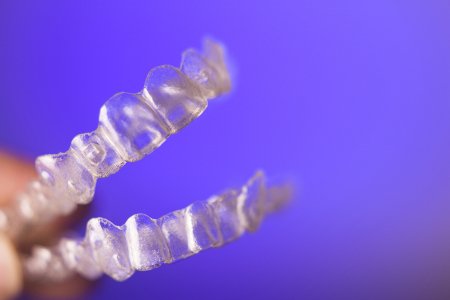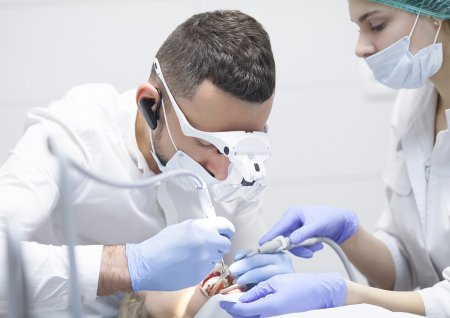-
Are Sealants the Solution for Tooth Decay?
Although they may look like it to the naked eye, the surfaces of your teeth are generally not smooth. They are usually covered in bumps, grooves, and ridges that can trap plaque and bacteria, causing tooth decay to develop. When you visit your dentist , the teeth cleaning performed during your visit will remove much of the trapped bacteria from the surfaces of your teeth, but this may not be enough to protect your teeth from cavities. In these cases, sealants can help. Could sealants be right for you? Here is what you need to know.

What are sealants?
Sealants are a plastic material that is painted on the surface of teeth. The material fills the grooves on the surfaces of the teeth so that bacteria cannot get trapped there. Typically, sealants are applied to the molars in the back of your mouth, where brushing and flossing can be particularly difficult.
Who can get sealants?
When sealants were first introduced, they were used almost exclusively on the molars and premolars of children and teenagers. Kids are especially prone to cavities between the ages of six and 14, so sealants can reduce the chances of decay during these vulnerable years. However, adults are not considered to be candidate for sealants if they do not have any existing decay on the teeth being treated. In some cases, sealants are also used on baby teeth, if the teeth have deep grooves. Baby teeth reserve the proper tooth placement for adult teeth, so keeping them healthy is important, even if they will eventually be lost.
How long do sealants last?
Typically, sealants last for about 10 years. However, during every dental exam, the dentist will examine the sealants to look for chips or wearing. Your dentist can replace sealants as needed to ensure ongoing protection.
To find out if sealants are right for you or your kids, make an appointment at Glenwood Premier Dental. We offer comprehensive care for the whole family, from implant dentistry to teeth whitening. Schedule your appointment today by dialing (732) 264-4477.
-
How to Insert Your Invisalign Aligners Properly
Invisalign is an excellent way to gently straighten your teeth without metal brackets and wires. Always wash your hands thoroughly before handling your aligners. Take out one clean aligner at a time, and rinse it briefly. Your upper aligner will be marked with a “U,” and the lower one features an “L.” It doesn’t make a difference whether you insert the upper or lower aligner first.

Gently push the aligner over the teeth in the front of your mouth. Then, place your fingertips on the two ends of the aligner, which should be positioned over your back teeth (molars). Apply gentle, equal pressure until the aligner snaps securely into place. Never try to bite your aligners into position, as this can damage them.
Invisalign treatment in Hazlet is available from Glenwood Premier Dental, along with a full range of other cosmetic dentistry services. Call (732) 264-4477 to request a consult with our orthodontist.
-
See Waterlase in Action
The next time your visit to the dentist reveals tooth decay, ask about Waterlase technology. Waterlase uses laser energy and a high-powered stream of water to gently remove decayed, infected matter from the tooth. Since this matter is softer than enamel, the healthy part of the tooth is left unharmed. You can see laser dentistry in action when you watch this video.
It’s a clip of “The Doctors” TV show, which features a dentist who demonstrates how she uses Waterlase to treat a cavity in her eight-year-old patient, Zack. Compared to conventional cavity treatments, Waterlase doesn’t require any injections to numb the area because it’s already completely painless. It also takes just a few minutes to complete the treatment.
Glenwood Premier Dental is pleased to offer state-of-the-art laser dentistry in Hazlet because your health and comfort are our top priorities . Get in touch with our friendly office staff by calling (732) 264-4477.
-
Your Post-Extraction Recovery Guide
Teeth don’t always last a lifetime. Gum disease, abscesses, and severe physical trauma are all common reasons why dentists sometimes need to remove a natural tooth. The good news is that your options for restoring your smile are better than ever. Once you recover from the extraction procedure, you could undergo implant dentistry procedures for a second chance at a beautiful, healthy smile.
Stopping the Bleeding
It’s normal to have a little bleeding when a tooth is taken out. Your dentist can give you a sterile gauze pad to bite down on. Try to keep it in place for about 30 minutes to stop the bleeding, or as directed by the dental staff. If you’re still having a little bleeding, place a moistened tea bag on the site and bite down gently on that.

Drinking and Eating
Once the bleeding stops, you should start giving yourself fluids. Avoid hot liquids—lukewarm and cool beverages are fine. Avoid using straws, as the suction can dislodge the blood clot. You should be able to eat about two hours after your appointment, as long as the bleeding has stopped. Stick with soft foods like yogurt, mashed potatoes, scrambled eggs, and cooked vegetables.
Minimizing Swelling
After any oral surgery, a little facial swelling is to be expected. Apply an ice pack wrapped in a towel to the exterior of your jaw. Ice the area for up to 20 minutes at a time, and then leave the ice pack off for 20 minutes before applying it again. Avoid using heating pads, as this will worsen the swelling.
Maintaining Oral Hygiene
Your dentist will give you instructions for brushing your teeth while the area is healing. About 12 hours after surgery, you may rinse and brush, but avoid the surgical site, and only spit very gently. Spitting forcefully can dislodge the blood clot. The day after surgery, you can start swishing gently with lukewarm salt water.
Here at Glenwood Premier Dental, we want to make your dental experience as positive and comfortable as possible. After your tooth extraction, you can have implant dentistry at our office to replace your natural tooth with a permanently secured, synthetic version. You can reach our implant dentistry office in Hazlet at (732) 264-4477.
-
The Smelly Truth About Bad Breath
Your mouth is home to millions of bacteria, and all of them can emit foul odors. Bad breath is a very common dental issue, and if it only occurs occasionally or when you first wake up in the morning, then it’s not generally a cause for concern. If your bad breath is persistent, it’s time to see your dentist. He or she can recommend effective treatment options for you, based on what’s causing the problem.
Poor Oral Hygiene
This is one of the most common causes of bad breath, also called halitosis. You can get halitosis even if you brush your teeth twice daily. It’s possible that you’re inadvertently missing areas. Try to brush one quadrant of your mouth at a time for at least 30 seconds before moving on to the next area. Flossing every day is a must, as a toothbrush can’t reach between the teeth.

Oral Infections
There are different types of infections that can affect your mouth and cause halitosis. One of them is gum disease, also called periodontal disease. It starts as gingivitis, which is the inflammation of the gum tissue. In addition to bad breath, you might notice that your gums bleed a little when you brush or floss. Gum disease won’t go away on its own. You’ll need to see a dentist for specialized care. Another type of oral infection is a dental abscess . This can cause intense, throbbing pain, pus, and sensitivity, and it warrants an immediate visit to the dental office.
Dry Mouth
Your salivary glands are located inside your mouth. The saliva they produce helps your mouth stay clean by washing away food debris, dead cells, and bacteria. If you have dry mouth, or xerostomia, then you’re more likely to have bad breath because these odor-causing bacteria and food particles will more readily cling to your mouth. Your dentist might recommend products designed to manage dry mouth.
For all of your oral health concerns, you can put your trust in the caring team at Glenwood Premier Dental . In addition to preventive care, we offer gum disease treatment and oral cancer screenings. If you’re looking for bad breath treatment and live near Hazlet, give us a call today at (732) 264-4477.
